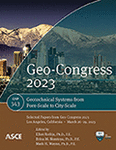Penetration Forces of a Rotating Helical Penetrator in Granular Media: Experiments and Insights into the Design of a Burrowing Robot
Publication: Geo-Congress 2023
ABSTRACT
It has been observed that some organisms such as Erodium seeds, snakes, and sandfish skink can bury themselves in the ground effectively and efficiently. These self-burial behaviors are achieved by one or multiple modes of locomotion including rotation, twisting, and undulation of an asymmetric body. To better understand the fundamental mechanism of these biological burrowing strategies, a series of upward and downward rotational penetration tests were conducted to evaluate the effects of rotational motion, asymmetric shape, and different properties of granular media on the penetration resistance using a robotic arm and 3D printed motorized penetrators. The results confirm that the downward penetration force decreases with the increase of rotational speed and that it further decreases if the penetrator is of a helical shape, highlighting the effects of asymmetric kinematics. It can be concluded that the penetration resistance of a helical penetrator depends on the rotational direction. For a right-handed helical penetrator, clockwise rotation resulted in significantly lower penetration force than counterclockwise rotation and required lower torque, although both reduced penetration force compared to non-rotational penetration. It was found that by coordinating the motions of the helical body, the penetration forces, and anchorage forces can be tuned to achieve self-burrowing.
Get full access to this article
View all available purchase options and get full access to this chapter.
REFERENCES
Dorgan, K. M. 2015. “The biomechanics of burrowing and boring.” Journal of Experimental Biology,218 (2): 176–183. https://doi.org/10.1242/jeb.086983.
Dorsch, D. S., and A. G. Winter. 2015. “Design of a Biologically Inspired Underwater Burrowing Robot That Utilizes Localized Fluidization.” International Design Engineering Technical Conferences and Computers and Information in Engineering Conference, V05AT08A045. American Society of Mechanical Engineers.
Elbaum, R., L. Zaltzman, I. Burgert, and P. Fratzl. 2007. “The role of wheat awns in the seed dispersal unit.” Science, 316 (5826): 884–886. American Association for the Advancement of Science.
Huang, S., and J. Tao. 2022. Bioinspired Horizontal Self-Burrowing Robot. 223–231. American Society of Civil Engineers. https://doi.org/10.1061/9780784484036.023.
Islam, M. F., M. R. Shaharear, and M. S. Islam. 2018. “Design and Implementation of 12 Channel Electrocardiogram Device.” 2018 10th Int. Conf. Electr. Comput. Eng. ICECE, 441–444. IEEE.
Koller-Hodac, A., D. P. Germann, A. Gilgen, K. Dietrich, M. Hadorn, W. Schatz, and P. Eggenberger Hotz. 2010. “Actuated bivalve robot study of the burrowing locomotion in sediment.” 2010 IEEE International Conference on Robotics and Automation, 1209–1214.
Maladen, R. D., Y. Ding, P. B. Umbanhowar, A. Kamor, and D. I. Goldman. 2011. “Mechanical models of sandfish locomotion reveal principles of high performance subsurface sand-swimming.” Journal of The Royal Society Interface, 8 (62): 1332–1345. Royal Society. https://doi.org/10.1098/rsif.2010.0678.
Moon, S. M., S. W. Hwang, S. M. Yoon, J. Huh, and D. Hong. 2013. “Bio-inspired burrowing mechanism for underground locomotion control.” 30th International Symposium on Automation and Robotics in Construction and Mining, ISARC 2013, Held in Conjunction with the 23rd World Mining Congress.
Okamoto, M., and S. Fityus. 2006. “An evaluation of the dry pluviation preparation technique applied to silica sand samples.” Geomechanics and Geotechnics of Particulate Media. CRC Press.
Pandolfi, C., D. Comparini, and S. Mancuso. 2012. “Self-burial Mechanism of Erodium cicutarium and Its Potential Application for Subsurface Exploration.” Biomimetic and Biohybrid Systems, D. Hutchison, T. Kanade, J. Kittler, J. M. Kleinberg, F. Mattern, J. C. Mitchell, M. Naor, O. Nierstrasz, C. Pandu Rangan, B. Steffen, M. Sudan, D. Terzopoulos, D. Tygar, M. Y. Vardi, G. Weikum, T. J. Prescott, N. F. Lepora, A. Mura, and P. F. M. J. Verschure, eds., 384–385. Berlin, Heidelberg: Springer Berlin Heidelberg.
Prayash, H. S. H., M. R. Shaharear, M. F. Islam, S. Islam, N. Hossain, and S. Datta. 2019. “Designing and optimization of an autonomous vacuum floor cleaning robot.” 2019 IEEE Int. Conf. Robot. Autom. Artif.-Intell. Internet--Things RAAICON, 25–30. IEEE.
Shaharear, M. R., H. A. S. Hossen Prayash, M. F. Islam, and T. Dey. 2019. “Low-cost u nderwater wireless communication system development using piezo-ceramic transducer.” 2019 1st Int. Conf. Adv. Sci. Eng. Robot. Technol. ICASERT, 1–4.
Stamp, N. E. 1984. “Self-burial behaviour of Erodium cicutarium seeds.” The Journal of Ecology, 611–620. JSTOR.
Tang, Y., S. Huang, and J. Tao. 2020. Effect of Rotation on Seeds’ Self-Burial Process: Insights from DEM Simulations. 293–301. American Society of Civil Engineers. https://doi.org/10.1061/9780784482834.032.
Tang, Y., and J. J. Tao. 2021. Effect of Rotation on Penetration: Toward a Seed Awn-Inspired Self-Burrowing Probe. 149–159. American Society of Civil Engineers. https://doi.org/10.1061/9780784483428.016.
Tao, J. J., S. Huang, and Y. Tang. 2020. “SBOR: A minimalistic soft self-burrowing-out robot inspired by razor clams.” Bioinspiration &$\mathsemicolon$ Biomimetics, 15 (5): 055003. IOP Publishing. https://doi.org/10.1088/1748-3190/ab8754.
Texier, B. D., A. Ibarra, and F. Melo. 2017. “Helical locomotion in granular media.” Physical Review Letters, 119 (6): 068003. https://doi.org/10.1103/PhysRevLett.119.068003.
Information & Authors
Information
Published In
History
Published online: Mar 23, 2023
Authors
Metrics & Citations
Metrics
Citations
Download citation
If you have the appropriate software installed, you can download article citation data to the citation manager of your choice. Simply select your manager software from the list below and click Download.
